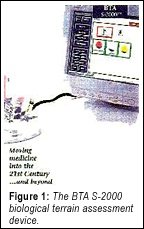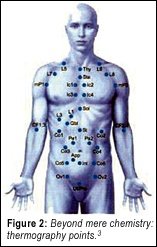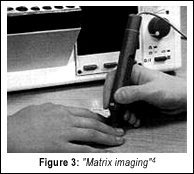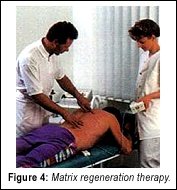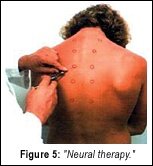In the second article we traced some of the history of the development of the competing models of disease arising in and from the 19th century. We distinguished the cellular theory of disease espoused by Rudolph Virchow from Claude Bernard's theory that disease starts as a result of regulatory dysfunction within the "internal environment." We noted that the "internal environment" has received various names in the literature and is currently often referred to as the "extracellular matrix." We sometimes refer to the internal environment by that term, or simply as the "matrix."
In the second article we also suggested that D.D. Palmer's disease model was perhaps based upon his reading of Dr. Bernard's works and, in any event, D.D.'s model was consistent with Bernard's work. We demonstrated that the understanding of the internal environment and its regulatory function was advanced in the early part of the 20th century by Terrence Bennett,DC, and later by the University of Vienna Medical School histologist Alfred Pischinger.
We will address the subject of the emerging scientific understanding of the "matrix" in our next article. Here we present some of the diagnostic and treatment options recently developed in Europe for the evaluation and treatment of the "matrix" (the body's regulatory mechanisms). Persons interested in exploring these matters further may wish to check some of the books listed at the end of this article.1
"Matrix" Points
The extracellular matrix is a single compartment that surrounds all organ cells and runs from the top of the head to the tip of the toes. "Information" is transmitted through this compartment virtually instantaneously. That is, the whole is always aware of what is going on in all portions of the internal environment - self-regulation system.
At its peripheral aspects, the "matrix" runs generally parallel to the surface of the skin. However, at various locations the "matrix" tissue projects perpendicularly to just below the outer layer of the skin in what have been histologically named "Heine cylinders." The German practitioners of functional medicine refer to these cylinders as "windows to the extracellular compartment," or "matrix." Many, but not all, of these cylinders are to be found at the same locations as many of the acupuncture points used in traditional Chinese medicine.
D.D. and Tone
Much of the contemporary work of the German practitioners of functional medicine deals with resonance within the internal environment. It is recognized that such resonance factors function energetically (biodynamically) and as information (bio-communication). We will address these points further in our next article. Suffice it to say for the present, it is important to distinguish between the concepts of energy and information from a scientific standpoint, but less so from a clinical perspective. It is the clinical aspects we are presently addressing.
We suggest that D.D. Palmer would have been comfortable with the concept of resonance that lay beneath much of the functional medicine being developed and practiced in Germany. In addition to having started his career as a "magnetic (resonance phenomena) healer," on page 19 of his 1910 book, The Science, Art and Philosophy of Chiropractic, D.D. stated:
"The amount of nerve tension determines health or disease. In health there is normal tension, known as tone, the normal activity; and strength and excitability of the various organs and functions as observed in a state of health."Of course, D.D. was focused on the nervous system; as the "internal environment self-regulation system." The science we will discuss in the next article demonstrates the principle of "tone" captures part of the contemporary picture emerging from the findings of basic science. However, the concept needs to be expanded to include not only the nervous system, but the whole functional unit described by Terrence Bennett,DC, and others. Chemistry is also involved in maintaining the integrity and functional capacity of the "regulatory matrix."
Biochemistry
In our prior articles we have pointed out that allopathic medicine has focused on the transportation function of the internal environment (extracellular compartment) and has, in general, failed to recognize the regulatory aspects of this tissue. However, at least one leading physician has recognized the importance of Dr. Bernard's concept of self-regulation. In discussing the work of Dr. Bernard, Philip Rhodes, professor of postgraduate medicine and dean of graduate medicine at the Wessex Region of the National Health Service in England, in his, An Outline History of Medicine (pp. 97-8) stated:
"In other words, the animal body is able to preserve a relative chemical constancy in the face of change that is being imposed upon it all the time. This (Dr. Bernard's) is indeed a remarkable concept, for it emphasizes the need for controls of the dynamism of the body ... This, therefore, is all about control mechanisms."
We agree that it is about "control mechanisms" and that "chemical constancy" is important. We will look at the chemical aspects of the internal environment being measured by practitioners of functional medicine. Then we will look further and include energetic/informational aspects of "internal environment - self-regulation paradigm."
The equipment pictured in figure one was developed by Dr. Robert Greenberg,2 an Arizona chiropractor, based upon the work of Professor Louis Claude Vincent, commissioned by the French government in the late 1960s to investigate why different regions of France had varying incidences of cancer. It is similar to an instrument first developed by the German firm, Medtronik. This technology measures the pH, the oxidative stress and the mineral status (concentration) of the internal environment ("matrix").
It is not our present purpose to elaborate on the significance of the factors cited in the preceding paragraph. However, a few words about that subject are warranted. Science has demonstrated that pH significantly affects enzyme kinematics and has a far-reaching influence on the functioning of the digestive system, the immune system and the lymphatic system. The pH is closely related to the patient's dietary habits and is amenable to being altered by, among other things, changes in the diet.
Oxidative-stress values indicate the electron movement and concentration within the "matrix." The effects of stress, poor air quality, and food lacking in nutritional value, along with a lack of aerobic exercise can result in abnormal values and a susceptibility to illness, disease, degenerative changes and premature aging.
The mineral concentration within the internal environment is measured as "resistivity" and if deficient will adversely impact enzymatic reactions. Conversely, elevated mineral levels may produce congestion and stagnation of the body's dynamic fluids and, perhaps, the energy/information systems designed to operate in self-regulation.
This technology can move practitioners way beyond hit-and-miss nutritional and related treatment approaches and can significantly aid in the development of a true era of "prevention and early intervention" medicine. But there is more to "self-regulation" than just chemistry.
B.J.-Bennet Revisited
Figure 2 shows some of the points at which temperature is measured in order to evaluate the functional status of the "internal environment - self-regulation" system. The measuring instruments utilize a thermocouple and the results are compared and contrasted with a normative database. A thermocouple device is used that is similar to that used by B.J. Palmer in the "neurocalometer"; the placement is obviously different.
It is often forgotten by contemporary chiropractors that Terrence Bennett identified many "neurovascular reflex" points on the anterior torso. We have not undertaken to correlate Bennett's points with those shown above, but it would be interesting to do so; or to otherwise evaluate them. (Bennett's points on the head are used in AK. His anterior body points can be found in Leon Chaitow's Soft-Tissue Manipulation. We will return to the subject of Leon Chaitow in our next article when we discuss the book, Energy Medicine: The Scientific Basis.)
In Europe, practitioners of functional medicine call the measuring process shown in Figure 2 "computerized regulation thermography." The process is being extensively used in Europe. An instrument to perform this process was recently "approved" by the Food and Drug Administration (FDA) for the evaluation of such things as breast cancer, vascular disease, and musculoskeletal disorders. The "medical-drug cartel" is, through the agency, forcing this aspect of functional medicine into the allopathic mold; the machine actually evaluates the "matrix." This sort of FDA action needs to be legally challenged.
According to Dr. Schultz-Ruhtenberg, a pioneer of thermography from Minden, Germany, "We can finally see what the body is doing before it becomes dysfunctional enough to create an irreversible problem." Again, prevention and early intervention are front and center.
Jim Parker Revisited
"Matrix imaging" is a name we have coined. The process depicted above is usually referred to as "electroacupunture according to Voll," or as shown, vegetative nervous system (VEGA) testing. Dr. Voll initiated the development this technology due to his involvement with both acupuncture and homeopathy. At first he used acupuncture points as the measuring locations, but it is now clear that the phenomenon actually being measured is, in fact, the (bio-electronic) status of the whole "internal environment - self-regulation system"; the "matrix." Therefore, points in addition to those developed within Chinese medicine can be used; that is the Heine cylinder, matrix points.
The first line of instruments to measure the depicted phenomena was manufactured by Pitterling Electronics of Germany and named the Dermatron. In the early to middle 1980s, "Dr. Jim" Parker sought clearance from the FDA to import the Dermatron instruments into the U.S. We are not sure what happened with respect to this matter, but the Dermatron has fallen by the wayside in the U.S.
Matrix imaging instruments, U.S., are being imported into the USA and some similar instruments are being manufactured here. In the U.S., the process is referred to as electrodermal screening. The terminology in the U.S. is dictated by the need to fit the technology into the allopathic paradigm in order to comply with FDA rules.
After making his initial discovery that one could evaluate the status of the "matrix" with the Dermatron, Dr. Voll learned that substances, especially homeopathic remedies, when introduced into the electronic circuitry of the measuring device, could alter a patient's readings. He further discovered, over a 40-year period, that the altered readings could be correlated with a beneficial or detrimental impact upon a patient's health status.
This "matrix imaging" technology has become a cornerstone of European functional medicine; both as an initial evaluation tool and as a monitoring device to measure the patient's response to treatment. Such instruments can be utilized with not only homeopathic remedies, but also allopathic and herbal medicines. The use of homeopathic remedies with this technology is, of course, not classical homeopathy, and is referred to in Europe either as "clinical" or "resonance" homeopathy. Perhaps the time was not ripe for "Dr. Jim"; it is now.
Removing Interference within the Matrix
The food we eat cannot be 100-percent utilized. What happens to the leftovers? Ideally, they are excreted. If not, they are stored as fat, and often as deposits in the "internal environment - self-regulation system" - the "matrix." Add to the food deposits the burden of the over seven million pollutants our new technologies have given us and one can quickly develop functional deficits that lead to chronic conditions such as rheumatism, MS, arthritis, cardiac insufficiency, allergies and cancer. Simply put, our bodies have not developed the ability to excrete many of the products of our Western lifestyle, both dietary and industrial. Again, German functional medicine has developed technologies to aid in the removal of such toxins from the "matrix." One such instrument is shown below. (We do not presently know the status of this kind of equipment with the FDA.)5
The process shown is a generalized treatment called "matrix regeneration therapy." It combines three separate processes within it:
- Petechial suction massage, a modern form of "cupping"
- Direct current treatment
- "Bioresonance" therapy (See Figure 5.5)
The treatment objective is to create a partial vacuum that mechanically loosens clogged deposits and toxins, then aids the body in excreting them through the lymphatic system. Resonance homeopathy is often used as an aid to or substitute for the type of procedure pictured here. We will address that matter further in a subsequent article.
The "matrix" is not only impacted by the types of generalized deposits addressed by the "matrix regeneration therapy" depicted above. More localized lesions can develop within the matrix, that can require more direct interventions than provided by the technology shown in Figure 4. A treatment for such problems was developed in the 1920s by the brothers Ferdinand and Walter Huneke. One application of this type of therapy is pictured below. It is "neural therapy" and utilizes local anaesthetics to remove storfelder (literally translated as "fields of disturbance"6).
The woman shown in Figure 5 is not being treated for myofascial pain, subluxation or as part of an acupuncture treatment. She is being treated to remove the storfelder that is contributing to a disease of her lungs. Although the term "neural therapy" is used to describe this type of treatment, it is now known that the procedure operates through the medium of the "internal environment - self-regulation system" - the "matrix."
Such treatment is virtually unknown in the U.S., although it has been in use by German naturopaths for over 80 years. We suggest that 80 years is long enough for patients in this country to await full-spectrum nonallopathic care.
After describing the treatment shown in Figure 5 as being designed to remove functional interference with the body's "self-healing mechanisms," a text5 states that "this principle (removing interference) is fundamental to ... acupuncture, chirotherapy ..." (It is a German book, thus the term "chirotherapy" is used in place of chiropractic.)
There is a problem with all of the clinical applications addressed here, as most would not fall within the chiropractic scope of practice in most states. We intend to do something about that. We trust that the conceptual relationship between the school of chiropractic developed by D.D. Palmer and the "internal environment - self-regulation paradigm" being developed in this series of articles is becoming as apparent to our readers as it is to us. It is time to accept the value of our founders' work, and their fundamental paradigms, and to bring them into the 21st century, based upon the latest scientific advances in the understanding of the "matrix" and functional medicine. We will address those subjects in our next article.
We take the opportunity in closing to remind our readers that we are in this series of articles only addressing part of the work of the chiropractic founding fathers. We also subscribe, and are willing to legally support and defend other founding principles, such as the statement of Dr. John Howard (founder of the former National College of Chiropractic):
"Our system is as broad as nature itself, and therefore embraces all natural methods, which possess virtue in assisting normal function of the body. The term 'physiological adjustment' speaks for itself: correction of body function by physiological methods."7
References
- a. Heine H, Ed., Matrix and Matrix Regulation, Basis for a Holistic Theory in Medicine, Haug Intl. 1991 (English Ed.)
b. Ho M, Popp F-A, Warnke U. Bioelectrodynamics and Biocommunication, World Scientific, 1994
c. Oschman J. Energy Medicine, The Scientific Basis, Churchill-Livingstone, 2000d. Bellavite P, Signorini A. Homeopathy, A Frontier In Medical Science, North Atlantic Books, 1995.
- Adapted from promotional materials for the Biological Terrain ("matrix") Assessment instrument manufactured by Biological Technologies International.
- Adapted from seminar handout materials relating to the CRT-2000 machine. The seminar was put on by Natural Healthlink.
- Adapted from promotional materials from the Grieshaber Akademie, Germany, manufacturers of the "Vega" equipment.
- Ibid. Those interested in the reference to "bioresonance therapy" relating to the "matrix regeneration therapy" should check: H. Brugemann, Ed., Bioresonance and Multiresonance Therapy (BRT), Haug Intl. 1993 (English Ed.).
- Dosch P. An Introduction to Neural Therapy Using Local Anaesthetics, Haug Intl. 1974.
- Beideman R. In the Making of a Profession: The National College of Chiropractic, 1906-1981, NCC, 1995, p. 39.
David Prescott MA,JD,DC,FIAMA
Silverado, California
Hon. Edwin Grauke,JD,DC
Lakewood, Colorado





